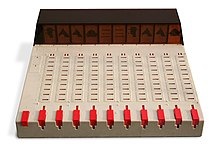Science kit

An experiment kit is a collection of teaching material for self-study, limited to one topic, typically packed in a box or cardboard box. The teaching material of an experiment kit consists of a selection of materials (e.g. chemicals, optical or electronic components), for which an instruction book encourages self- experiment ( experiment ) or the construction of apparatus.
General
Experiment kits mostly want to impart scientific or engineering knowledge to their users . The classic experiment kits offer an introduction to the sub-disciplines of chemistry , mechanics , optics , electrical engineering or electronics . The target group of such teaching materials are mostly children and young people from 6 to 18 years of age. Experiment kits are usually graded according to age groups and corresponding levels of difficulty. They are advertised by their manufacturers as educationally valuable toys that promise users a deeper insight into the respective discipline . However, some teaching aids only partially meet this criterion because they only address the topics covered in a playful way and do not train any transferable skills. Serious experiment kits, on the other hand, seriously introduce their scientific discipline by guiding from the observation of individual phenomena to the knowledge of general laws. Boxes for electronics usually contain commercially available components that are connected to one another on a manufacturer-specific connection system or on a breadboard . The provision of all the necessary components , the visually pleasing assembly and the written explanation of all the experiments described make the experiment kit stand out from the individual purchase of individual parts and secondary literature .
history
From the 1920s onwards, the first experiment kits in Germany were the kits from the teaching materials department of the Franckh'sche Verlagbuchhandlung W. Keller & Co. (now KOSMOS ) with their Society for Friends of Nature . In 1922 the electrical engineering experiment kit came onto the market. The development of the Trix metal construction kit began in 1927 under the leadership of the Nuremberg toy manufacturer Andreas Förtner & Jürgen Haffner GmbH . 1934 appeared Radiomann of Wilhelm Fröhlich . Other topics followed, such as the optics for building a camera and kits for telescopes . A whole series of experiment kits were created, some of them from electronics manufacturers such as Philips . With these, generations of young people have been introduced to natural and engineering science topics.
Experiment kits were and are subject to fashions and trends over time, as well as technical progress and changes in legislation ( product liability ). Chemistry experiment kits were / are not delivered with all substances, or experiments that were considered dangerous disappeared. The introduction of digital technology into electronics experiment kits is an example of technical progress . Environmental protection experiment kits, which only enjoyed a short period of popularity, were a temporary phenomenon . A trend since the 2000s are editions that are very reduced in terms of content (sometimes as an extract from a more extensive package), which often only comprise a few attempts on a specific topic and, due to their relatively low price , are intended for curious beginners or as a souvenir .
Originally, an experiment box was, true to its name, a wooden box with a sliding lid. Later it became cardboard and plastic packaging.
quality
The value of an experiment kit results from the compilation, which should enable as many experiments as possible, including your own experiments, and above all the instruction book that should describe the experiments and the scientific background in an understandable way. A good experiment kit gives beginners interested in electronics the opportunity to set up devices that have already been tried and tested.
Manufacturer and market
In Germany, Franckh-Kosmos- Verlag has dominated the market under the name KOSMOS since the beginning . The number of experiment kit manufacturers has decreased significantly since the 1990s. For example, the well-known boxes from Philips and Schuco have disappeared from the market. Occasionally, Asian manufacturers appear briefly with individual boxes without a product line (no extensions available) and without a spare parts service. Quality and educational suitability must be checked here.
Historical experiment kits have become a separate area for collecting, complete kits are in great demand. This also includes the Braun Lectron electronic experimentation system, first presented in 1966, or the comparable Simulog .
Individual evidence
- ↑ http://www.experimentierkasten-board.de/viewtopic.php?f=1&t=773
- ↑ http://ee.old.no Philips "EE" electronic experiment kits


